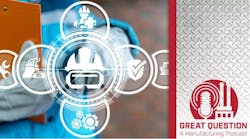Dave Blanchard, editor in chief of EHS Today, a sister brand to Smart Industry, recently spoke with managing editor Nicole Stempak and senior editor Adrienne Selko about how the field of industrial healthy and safety is evolving and how to prepare for these inevitable changes. In this episode, they discuss:
- Workplace stress and its true cost to employers
- Industrial robots and their potential to reduce injuries
- Safety lessons learned from the Baltimore bridge collapse
Podcast: Accessing data and clearer paths to drive your digital transformation
Below is an excerpt from the podcast:
I'm going to talk about industrial robots and their ability to reduce injuries.
Last month, I was watching a video for the humanoid robot called Apollo that was working in a Mercedes-Benz plant. It was lifting and carrying heavy boxes, putting things on shelves, and performing a number of tasks that are less than ideal for people to perform.
See also: Future-proofing your operations: Automation support through the looming labor crisis
My first thought was this should really be able to move the needle on unnecessary injuries in a warehouse or distribution center. So, I looked around to see what information was out there, and it turns out the National Safety Council also sees potential for improvement with robots working alongside humans.
They highlighted this issue in their 2023 report called “Work to Zero,” and they looked at the whole gamut of robots, including autonomous, mobile robots, automated guided vehicles, articulated robots, humanoid robots, and collaborative robots.
See also: Manufacturers should view emerging tech as relief from the workforce crunch
They found that these are the areas where robots can improve working conditions: confined entry inspections, handling hazardous material, reducing the risk of human exposure to toxic gases, high temperatures, electric shock hazards and also falls from heights.
They also noted that cobots and robotic arms are well established for repetitive manual tasks such as machine tending, parts repositioning, and pick and place. Such deployments can reduce the risk of musculoskeletal disorders from repetitive manual work and allow workers to focus on more varied, complex tasks.
The CDC also highlights this and talks about a number of ways that robots can help us avoid specific dangers. They gave a couple of examples such as robots can inspect offshore oil rigs while people remain safely on shore, and a fleet of self-driving vehicles could reduce motor vehicle crashes among delivery workers.
Video and audio: How the 'DIY' approach can help your industrial automation
In a study from 2002 called “Industrial Robots, Worker Safety and Health,” data was used from OSHA covering the period from 2005 to 2011, and they reported a one standard deviation increase in robots reduced the work-related injury rate by 1.2 injuries per 100 full-time workers. This is good news.
There, of course, is another side to this, and that is that sometimes robots can add safety hazards. Probably many of you are familiar with the recent case of a robot in South Korea crushing a worker to death in a vegetable packing plant in November 2023. Unfortunately, that is not the only fatality.
A 2022 report from the CDC found that 41 U.S. workers were killed in robot-related workplace incidents over a 15-year period. The vast majority of these deaths took place while a person was performing maintenance on a robot.
The Brookings Institution weighed in as well. Research from 2023 pointed out that some robots lack the necessary sensory capabilities to detect humans and, of course, this creates a safety risk.
What We Learned: Expertise and Episodes from Three Years of ‘Factory Talk’
The group refers to an estimate by The Center for Investigative Reporting based on 150 warehouses analyzed over a four-year period and suggested that warehouses with robots experienced 50% more injuries.
On the other side of that study, Brookings said that this analysis might not be completely correct, as probably some of the facilities that were chosen to bring robots in had higher injury rates to begin with.
But there are a number of organizations that are trying to help companies address this issue. The Center for Occupational Robotics Research, which is part of NIOSH, issued a report in 2017 called “Protocol for Assessing Human-Robot Interaction Safety Risks.”
They also disseminated an OSHA technical manual on robots and robot system safety. An industry group called A3, formerly the Robotics Industry Association, has been involved in safety standards for robots as well as introduced a new standard. They also offer training for mobile and collaborative robots.




